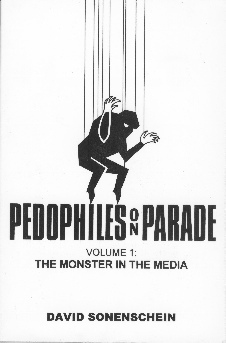Pedophiles on Parade

Pedophiles on Parade is a 1998 two-volume book by sex researcher and anthropologist David Sonenschein, elaborating a detailed analysis of how images of the pedophile as a cruel and sadistic villain were propagated throughout the late 70s, 80s and 90s. The book was once temporarily removed from Amazon's online bookstore, following furore over Viamund's self-published volume.
Review from NAMBLA:
Pedophiles On Parade is the finest analysis of Child Molester Hysteria that we have seen. The author fearlessly reveals how adult villains, child victims, and heroic authority figures are invented and reinforced by the government, the media, and special interest groups with repressive social agendas.
Pedophiles on Parade, Volume I
From the author's website:[1]
Using data collected over a decade, this volume documents popular ideas of adult-youth sexual relations from the mid-1970s into the 1990s, a period now known as the child sexual abuse hysteria. Looking critically at both fiction (including film) and journalism, core elements of villains, victims, and heroes are drawn out and shown to be interconnected. Sources widely distributed as well as those inaccessible to others are examined and tied to a variety of products and processes of American culture to yield the most complete and in-depth study yet available of this crucial period and issue.
During the 1980s, conceptions of the child molester and the child victim were based on simplistic or incorrect assumptions, incomplete or skewed data, and distorted by personal and institutional biases. The result has been an irrational panic extracting high costs financially, personally, and socially.
Contents
I. Introduction
II. Part One: Popular Fiction
Chapters: The Pedophile in Fiction, The Social Pedophile, The Fictional Victim, The Fictional Hero
III. Part Two: Popular Fact
Chapters: The Factual Pedophile, The Factual Victim, The Factual Hero, The Hero in Society
IV. Afterword
Pedophiles on Parade, Volume 2
From the author's website:[2]
The child sex abuse hysteria of the 1980s serves as a reference point for a far-ranging cultural historical survey of the ways sexual villains, victims, and heroes have been constructed and used on America. Including an extensive and and unique chapter on “The Sexual Child” - one of the most avoided and undocumented subjects in history, social science, and policy research - a varied number of contemporary and historical influences are brought together for the first time around the subject of adult-youth sexual relations.
Flawed from the beginning, images of sexual actors and events have remained so because America’s use of them has traditionally been for entertainment and for the advancement of particularistic political agendas, rather than for the empirically based rational and humane guidance of public policy and personal conduct.
Contents
I. Introduction
II. Part One: Historical Roots
Chapters: Relativism, Innocence, and Evil, The Sexual Child, Child-threatening Figures, Children and Reform Movements, Roots of the Sex Fiend
III. Part Two: Pedophilia and Popular Culture
Chapters: Images as Spectacles, The Villain as Spectacle, The Victim as Spectacle, The Spectacle as Hyperreality, Criticism and Persistence
IV. Afterword
External links
- A BoyWiki article about the book.
- The whole book - On Libgen.